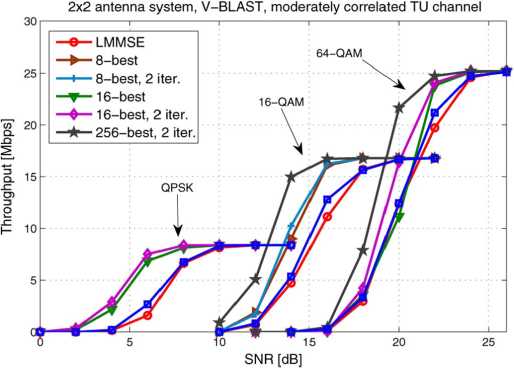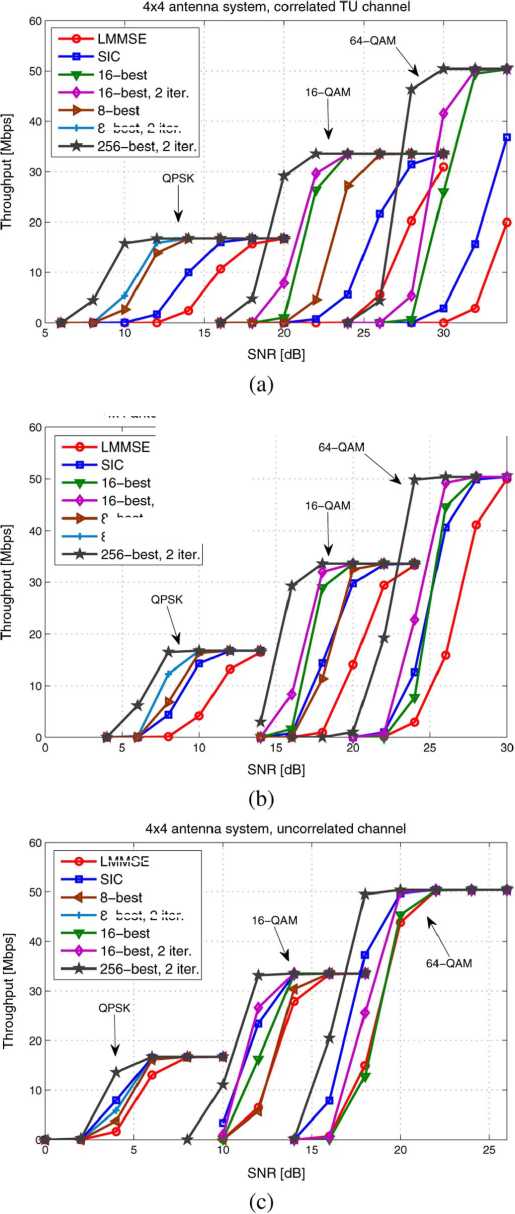KETONEN et al.: PERFORMANCE-COMPLEXITY COMPARISON OF RECEIVERS FOR A LTE MIMO-OFDM SYSTEM

Fig.7. Data transmission throughput versus SNR ina2 × 2 V-BLAST system
and moderately correlated channel.
The simplification has again only a small impact on the per-
formance. Comparison of implementations done with the Cata-
pult tool showed that the FPGA complexity is reduced approx-
imately four times with the simplified LLR calculation. Also
the SIC receiver is simplified from using soft demodulation for
LLR calculation to using the approximate log-likelihood crite-
rion. The symbol expectations are also calculated with (14).
IV. Implementation Comparisons
The theoretical complexity of the receivers with M = N is
presented in Table III, where the number of multiplication, ad-
dition, and comparison operations are specified. The memory is
the number of bits used in each block. In the squared Givens ro-
tations (SGR) and the Gram-Schmidt based QRD, the division
and square root were approximated with additions and shifts
[28]. The M3 term in the SGR comes from matrix multiplica-
tions and in the QRD from multiple iterations of vector mul-
tiplications. The number of operations in the A?-best algorithm
depends on the list size K. If K is larger than √zΩ^ ŋ, it is used
as K. In the first level I, the number of multiplications is 2vzΩ
and additions √zΩ. The LLR calculation operations for the linear
receivers depend on the modulation. The constant multiplica-
tions with a power of 2 were calculated as shifts. The number
of multiplications is lower in the K -best LSD than in the SIC
with 4×4 QPSK. The number of multiplications in the A'-best
algorithm increases with the list size and modulation. The mod-
ulation order does not have a major impact on the complexity
with the SIC receiver. The impact of this can be seen later in the
implementation results. The SIC receiver includes more multi-
plications than the K-best algorithm with 4 × 4 QPSK and the
implementation gate count is also higher. With 64-QAM, the
number of multiplications and gates is higher with the AAbest.
Catapult C Synthesis tool [29] was used in the implementa-
tion of the receivers. It synthesizes algorithms written in ANSI
C++ into high-performance, concurrent hardware. This single
source methodology allows designers to pick the best archi-
tecture for a given performance/area/power specification while
minimizing design errors and reducing the overall verification
3365

8-best, 2 iter.
LMMSE
8-best, 2 iter.
Fig. 8. Data transmission throughput versus SNR in a 4 × 4 system in (a) a
highly correlated, (b) moderately correlated, and (c) uncorrelated channel.
4x4 antenna system, moderately correlated TU channel
8-best
8-best, 2 iter.
burden. While the results may not always be as optimal as with
hand-coded HDL, the tool allows experimenting with different
architectures in a short amount of time and the comparison
of different algorithms can be made, provided they are imple-
mented with the same tool. The complexity results seem to be
More intriguing information
1. An Incentive System for Salmonella Control in the Pork Supply Chain2. Errors in recorded security prices and the turn-of-the year effect
3. AN ANALYTICAL METHOD TO CALCULATE THE ERGODIC AND DIFFERENCE MATRICES OF THE DISCOUNTED MARKOV DECISION PROCESSES
4. Language discrimination by human newborns and by cotton-top tamarin monkeys
5. Improvement of Access to Data Sets from the Official Statistics
6. The name is absent
7. Partner Selection Criteria in Strategic Alliances When to Ally with Weak Partners
8. Subduing High Inflation in Romania. How to Better Monetary and Exchange Rate Mechanisms?
9. GOVERNANÇA E MECANISMOS DE CONTROLE SOCIAL EM REDES ORGANIZACIONAIS
10. The name is absent